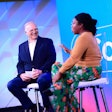Yes, I have a Facebook page and a Twitter account. Both were started in a moment of panic—thinking I was about to be left behind on the barren island of mainstream (or lamestream, as per Sarah Palin) media, watching while the nimble and able sailed off on the cruise ship of the future, Technologica.
But every time I log on, I’m overwhelmed by the unwanted obligation of it all. Friends who want responses, new followers for whom I have nothing to tweet. The most guilt-laden of these spots is Linked-In—people who want recommendations, referrals, or career advice, none of whom I respond to. Will they lose a job because I’m too lazy? Who knows. By the time I’ve read the new messages, I’ve lost interest in the whole thing.
While ashamed of my Ludditism, I always took solace in sensing that I wasn’t missing much. There’s Demi Moore, again, posting pictures of herself in bed with Ashton (as if that would throw us off the scent). Or Palin making her political prognostications. (She’s one of the few who has no problem getting the bulk of her wisdom across in the allotted 140 characters.) And all those bullies, posting hate speech on each other’s walls. It just seems to me that social media is one whole world of self-promoting jackasses.
And now I’m hearing about tweeting at events. Nick Cannon offered to send three sponsor tweets at one of his two 30th birthday parties for the princely sum of $25,000. Yikes. Then somebody sent me the deck for Robert Verdi’s Twitter parties, which are imaginatively called “Tweet This!” Now, I know and like Robert; he’s been interviewed here before, he has clever entertaining ideas, and, despite his own somewhat exaggerated appearance, good taste.
But after spending an entire afternoon researching his new business model, I have to admit I’m just completely bamboozled. But here’s what I figured out.
Robert owns this loft in New York, which he calls Luxe Laboratory. He rents it out for events, and throws parties promoting his own brands. Approximately once a month he does a themed Twitter gathering. In September there’s Fashion Week (duh!), and holiday gift giving in December (double duh!).
Not all the months are as “luxe” as others. In one video, Robert holds up a soiled glass bowl while talking about toilet cleaning. It’s a “Spring Cleaning” party sponsored by Scrubbing Bubbles. I was also a little surprised to see a Panasonic electric vibrating chair touted as one of the Fashion Week must-haves. My grandfather had a magic fingers chair. He died 15 years ago.
The events are attended by 30 to 40 “key online editors and influencers.” Sponsors’ products are shown on a plasma screen, aired on UChatLive, and simultweeted at robertverditweetthis.blogspot.com.
The idea is that while he demonstrates the products, his influencers are tweeting to their followers, and they tweet to friends, and they tweet to friends, and so on and so on just like that shampoo commercial. The incentive for retweeting is a gift bag of all the products featured. To be a sponsor, companies pay between $2,500 and $10,000 for two or three tweets and one TwitPic. Some sponsorships are given away for free. But the sponsors don’t know who pays what, if anything, according to Ashley Mallinson, who runs the program with Robert. There’s all sorts of other bells and whistles you can add on, like a branded Twitter competition and brand-specific tracking and metrics. And the promotional material variously boasts a million followers per event and a cumulative program reach of five million. It’s all very ambitious and ambiguous.
Ashley explains that they arrived at their audience claims using a program called Spredfast. Robert himself has more than 16,000 followers, and if you add up the total number of followers of every Web site and every tweeter, I suppose it’s possible to get a figure in the millions. But how many of these are really being read?
When you go to his actual Twitter page, it’s clear that the event attendees are tweeting away like fiends to get their free goodies. But as a friend whom I asked to help me evaluate this program wrote me: “Who the hell are these people retweeting ‘Once you try Smartwater you’ll agree it’s the “smartest” choice in bottled water’? Actually, seriously—who the hell are these people?”
Maybe I’m missing something, but despite my respect for Mr. Verdi, to me this all seems to add up to an elaborately staged hill of beans. Just in time, The New Yorker arrived with a Malcolm Gladwell piece, “Small Change: Why the revolution will not be tweeted.” Gladwell debunks the myth that Twitter helped drive the Iran election revolts (all the tweeters that got media coverage were in English, while in Iran most people speak Farsi), and explains that while social media is able to reach large audiences very quickly, those audiences’ level of involvement is extremely low. (“The Facebook page of the Save Darfur Coalition has 1,282,339 members, who have donated an average of nine cents apiece,” he points out.)
In the movie The Social Network, Facebook founder Mark Zuckerberg’s character repeatedly asserts that once the site starts accepting advertising, it will no longer be cool. I think the idea of paid tweeting for toilet bowl cleaners proves his point.
Which brings me to my point, rather abruptly. Yo! Event people! Take heart. The real social network is still you guys, putting people together in person. Where interesting locales, meaningful content, and thought-provoking design can still do magic. And where tweets can only follow.



















